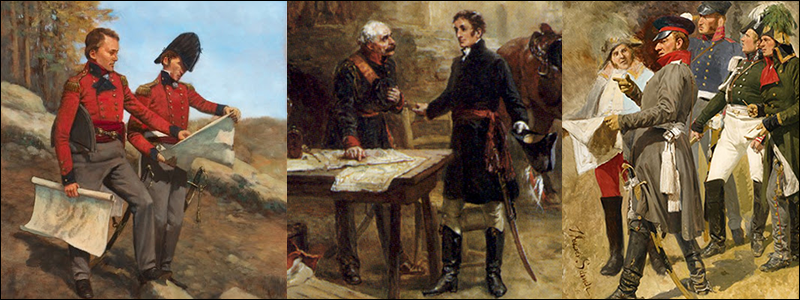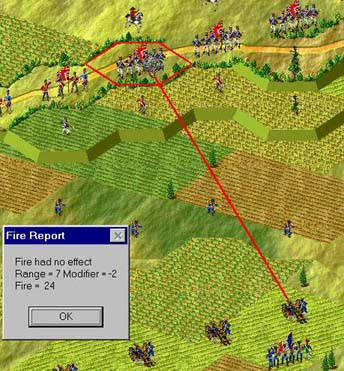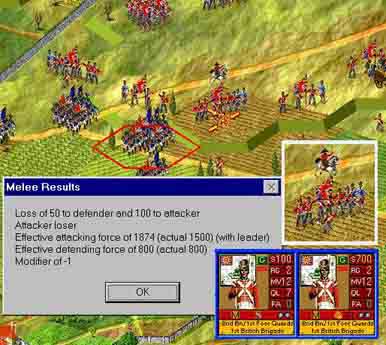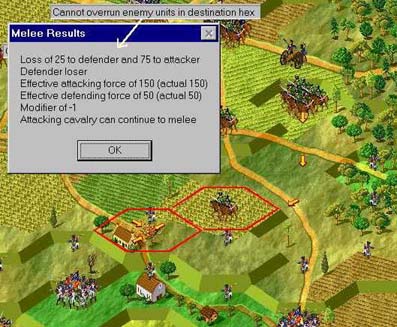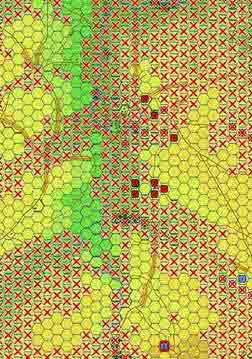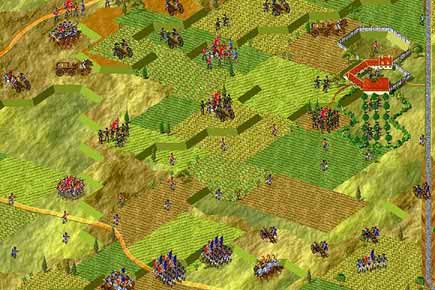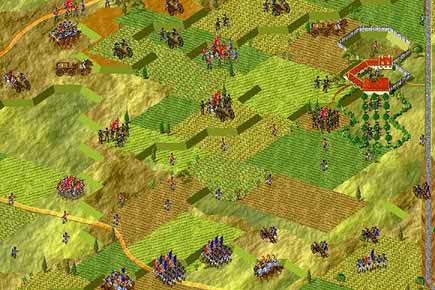|
Allied Training College (ATC) Coalition Library |
Skirmisher Lore [Written by John Pumphrey - Napoleonic Wargame Pages] |
Skirmisher Lore Part I 1) Harrassing the Enemy Line The primary function of a skirmisher unit is to cause disorder and loss to enemy line units by fire alone, and perhaps even to rout them. 'The first [goal] was to engage the enemy's formed units and pepper away at them until their moral was so shaken by the continual effect of seeing people falling around them that they would break when attacked by formed infantry.' 1 Battleground simulates this well. A unit already disordered prior to melee does indeed pick up a -1 rout modifier. This 'softening up' process can mean the difference between the success and failure of an attack, not in the sense that disordered units defend less well, but in the sense that they are more likely to rout. Even better than just disorder, skirmishers can inflict considerable fatigue if allowed to pick away over a period of time, and fatigue penalizes the enemy with negative melee modifiers as well as rout modifiers. Historically, a distinct tactic of the skirmishers was to fire at the leadership element of the line units. This is not visible in the Battleground games, as the leaders in such cases were mainly at the platoon, company and battalion level. It is rather part of the general concept of disorder. A clear example of skirmishers going quite a way towards winning a battle is that of the French at Jena, where Hohenlohe's infantry before Vierzehnheiligen, while admittedly fatigued and demoralized by futile attacks on that village, and also fired upon by artillery, were nonetheless primarily routed by skirmishers, against whom they appear to have been completely unscreened by skirmishers of their own. They stood in that fashion in squares for nearly two hours, as Petre tells it... Historical: '[Massenbach's advice to drive forward] was not taken, or at any rate not acted on, and the line remained in its position, suffering more than the best troops could be expected to bear for long. Already one regiment on the left, which had shown symptoms of breaking, had only been held in place by immense exertions, even by violence, on the part of the officers. Young Eberhard, the junior officer of the Sanitz regiment, a mere child still, seized the colours, shouting to the men, "See! here is your standard; it you must follow." He fell, pierced by many French bullets, still clinging to his colours. In vain his heroic effort, and those of many others; the men could stand no more. Regiment after regiment began to fall back. For half-an-hour some sort of order was maintained; but by two o'clock the whole left and centre, from Isserstadt to beyond Vierzehnheiligen, was a confused mass of panic-stricken fugitives. Arms were thrown down, guns abandoned; men yielded themselves prisoners in hundreds to the pursuing French.' 2
2) Screening Your Own Line Shooting through skirmishers picks up a -1 modifier, so putting skirmishers ahead of your infantry is the same as putting the infantry behind a hedge. 'The second function of a skirmish screen was to protect the friendly forces behind it from the fire of the enemy's skirmishers. This they did by engaging the enemy skirmishers and physically preventing them from approaching the friendly lines.' 3 This is reflected in the Battleground series by the -1 modifier against fire through a skirmisher line, but somewhat oddly artillery fire picks up the same negative modifier as fire from formed infantry units and other skirmishers. Artillery on higher ground can shoot over the heads of the skirmishers up to about 5 hexes or so, ie. without picking up the -1. This plus the cavalry threat are good reasons to keep skirmishers close to your line units, where they have a better chance of protecting such units from fire. In an extended firefight they can quite likely save more than their own weight in casualties. This of course can work against you as well, so the best position for artillery is at the edge of high ground, and shooting over your skirmisher screen below. Note that the -1 modifier is cumulative with other types of negative modifiers, but not cumulative with other skirmishers. Thus shooting through a skirmisher and a hedge will pick up a -2 overall, but shooting through a friendly and an enemy skirmisher will only pick up a -1 overall.
Diagram: In this illustration from Waterloo, the Allied skirmishers and a hedge have together imparted a -2 modifier to what would otherwise be strong French artillery fire. The French skirmisher screen is correctly placed in the depression beneath the artillery. Although unprotected by LOS, there is no cavalry threat in this part of the field. Such placing does not help the French in this instance as a double line of skirmishers does not inflict a cumulative modifier.
3) Protecting Your Flanks This can be broken into two parts: a) A skirmisher placed in a hex flanking the parent unit will prevent an enemy infantry unit from swinging in against the parent's flank. b) A skirmisher placed WITH an infantry unit negates the -2 modifier which your opponent would get if he managed to melee it from the flank. The skirmisher has to be facing in the correct direction, namely towards the flank hexes not covered by the zone-of-control of the parent unit. This is rather painstaking to implement since the skirmisher's facing does not come up in the unit dialogue. You need to be sure though that the skirmisher is not in a higher fatigue bracket than the parent unit, else it can add up to -2 against you in melee anyway. Yet another good reason for looking after the skirmishers that belong with their parent units.
Diagram: This melee looked like a reasonable chance for the French. While two against one are not great odds uphill against guards (-2 modifier), the French get a +1 for their leader and another +2 for a flanking attack. Not so? Actually it is not so at all. The skirmisher has negated the +2 flanking benefit, and instead the French get a -1 modifier overall, and pay the penalty. Note the facing of the skirmisher in the blow-up. Had he been facing forward, the overall modifier would have been +1 to the French.
4) Holding Terrain Skirmishers are useful in holding ground when their parent units need to keep their heads down, provided that the terrain is selected carefully. Thus skirmishers in unclear hexes, including buildings, not only stop cavalry charge overruns, but negate the times-three bonus in the melee. So placed they are as good as, and a lot cheaper than, a cavalry screen.
Diagram: In this shot from Battleground Waterloo a new lieutenant, out of frustration and seeking a speedy breakthrough, or even merely some intelligence of what lies beyond, has had his Prussian advance guard charge a Young Guard skirmisher unit in a building hex. The first message (status bar) shows that no overrun is possible. The charge is stopped. Worse news awaits our intrepid lieutenant. The melee results are awful, there being no times-three factor, the skirmishers suffer the usual reduced casualties, and on top of that a melee modifier of -1. How not to win Waterloo!
Footnotes 1 Nafziger, G.F., 'Skirmisher Tactics in the Napoleonic Wars Part I: Intro and France', Empire, Eagles, & Lions Vol. 2 No. 14.
|
Skirmisher Lore Part II 5) Outflanking Enemy Line Units Where possible, you should use skirmishers to outflank enemy line units. and even to get behind those units. This may assist in a zone-of-control (ZOC) capture, where the line unit cannot retreat and is removed. 'Various sources indicate that the French skirmishers were quite adept at penetrating larger holes in the enemy battle formation and positioning themselves such that they could fire on the flanks of the forward units.' 1 The ZOC capture is one of the more controversial aspects of the Battleground games. However, I particularly like this quote from Paco Palomo, which I saved from the NWC message board: 'I would agree that a company of 50-100 men could not physically prevent 500-1000 fleeing enemies from barreling over them. However, it bears mentioning that the "elimination" of a battalion in the game does not necessarily represent the capture or death of an entire unit. Rather, it represents the fact that an entire unit has lost its cohesion and/or unit integrity to the point that it is 'hors de combat' for the rest of the battle. The unexpected appearance of organized enemies in the rear of a defeated unit is precisely the type of event that would lead to the complete disintegration of all order and the scattering of a unit for the remainder of the day.' This does not mean of course that you should send skirmishers in great sweeping movements behind enemy lines like some kind of 20th Century commando raid. Not only is it ahistorical, but a good opponent will be keeping an eye out and will rapidly chew them up with overruns by his reserve cavalry at no loss to himself.
6) Holding a Chateau Skirmishers are the best units to hold a chateau. Units in line, which would have had to start the scenario that way if they are to be undisordered, are very susceptible to artillery fire in the flank. Units in column remain vulnerable to very close fire and can be meleed in the flank. Finally, squares while having no flanks, have added vulnerability to artillery fire. Placed in a chateau, skirmishers will still take artillery hits, and may rout, when at strengths above 250 men, but no experienced player will even think of wasting ammunition when your strength falls below that. Guards make the best garrison for a chateau as they pick up an additional modifier favourable to you. In addition witholding fire in the defensive phase when a melee is pending will pick up a further one. And finally, if the chateau is really important to you, placing a leader there will pick up yet another favourable modifier. In such cases add an ammo wagon, which will allow your skirmishers to continue firing longer. Indeed if you have no ammo wagon, your garrison should avoid firing, as you want to avoid any negative "out of ammo" modifiers at all costs. Since meleeing a chateau requires odds of at least 4-to-1, and more against guards, and the attackers will become fatigued before the defenders, a good strong garrison of 250 guards handled this way forces your opponent either to waste an inordinate number of his own skirmishers, or else to risk his line units. Such a garrison will almost certainly survive longer and in better order then one consisting of far larger strengths of infantry in column or square. Need a really strong chateau garrison? Well there is one other thing you could add to your little skirmisher garrison. It's not infantry. It's certainly not cavalry. It's... (I'm almost too afraid to tell you).
7) Reconnaissance Skirmishers are also critical to your reconnaissance efforts. Is there anything hiding in that ditch yonder? Send out a skirmisher unit. They are also very useful placed up on any available high ground, including high ground behind your position, and sent way out on your flanks to make sure your opponent isn't concocting any plans there. And then don't forget to sweep that forest you're passing by. "When operating in broken terrain, it was the mission of the skirmishers to search through all the cover the might conceal any possible ambush. [...] The objective being to expose and turn any ambushes. To do this some individuals were expected to seek high points and expose themselves to the enemy, thereby causing the enemy to think that his position was turned." 2 Historically, cavalry vedettes were not the only instruments of reconnaissance. Here's a lovely quote from Marbot's memoirs: Historical: 'I entered now upon the vast and dreary plains of Old Castile. At first sight an ambush seems quite impossible in this treeless and mountainless country; but it is so undulating that this apparent security was deceptive. The hollows between the frequent hillocks allowed bands of insurgents to hide, and pour forth unawares upon French detachments, marching with confidence through a country where they could apparently see four or five leagues all round them and discover no enemy. A few disasters had made our men more cautious, and they no longer crossed the plains without searching the hollows with skirmishers.' 3 'Pour forth unawares'. Beautifully simulated by Battleground Fog of War. Whilest true that the above describes a strategic route march, it applies just as well to a tactical or battlefield situation.
Diagram: Here a single French skirmish unit (bottom of screen) keeps track of the greater part of the Allied far right wing at Waterloo. It is in a position to pick up almost all movements on the flank as the low ground is barely continuous. You will note however, that there is a ditch running North-South through which an allied 'raiding party' could still pass unseen, and you'll need to plug that with one more skirmisher. Has an opponent of mine ever tried such a 'raid'? Yes, one did... and paid for it. A historical ploy? Absolutely not.
8) Supporting with Parent Units One possible use of the parent light units is as reduced lines or squares to protect an advanced row of skirmishers from being overridden by enemy cavalry. Breaking down the light units till they are only 125 or so in strength leaves a residual unit that is more valuable formed than as just another skirmisher. These residual units can be brought up close to the the skirmish line, or used in the same hex as artillery batteries, under circumstances where the full strength battalions are better advised to keep their heads down. While true that such reduced units are vulnerable to artillery fire, and may indeed be entirely wiped out in just a few turns, they will meanwhile help to protect your skirmisher line, the value of which you should never discount. A line of skirmishers can often amount to some six or eight hundred men who cannot easily be replaced. In considering the historical analogy of this, one notes that skirmishing companies were seldom broken down completely into a skirmish line. Rather the skirmish line itself (pairs of men in open order, one loading and the other firing) consisted often of only a third or so of the company strength, the remainder of the company remaining formed and in close support. 'The Austrian 1807 regulation clearly states that it was the third rank of the infantry company that was detached [as skirmishers]. [...] The skirmishers moved at the doublirschritt and opened up until they were at six pace intervals. The skirmish screen established itself 300 paces in front of the battalion. About 80-100 paces behind the screen a Zug stood in closed order to act as a reserve and quick support for the skirmish screen. At 100 paces further back the captain stood with the two remaining Zügen of the company as yet a further reserve.' 4 A Zug is roughly a double-strength platoon. Now this analogy with the supporting formed unit as I outlined it at the start of this topic is not of course accurate. In that case, one is talking about a residual formed battalion, which is not at all the same thing as the supporting company, or its platoons, in the historical example. Nonetheless, it's as close as one can get in the Battleground games to the idea of a formed support for the skirmish line. Just remember though that such use of the residual battalion is just a gaming hint and not a historical description in this case. Historically the skirmish line was indeed far more complex than the Battleground® engine really suggests, and that most people visualize. It was not just a few little fellows hiding in the bushes, but a multilayered deployment, capable even of forming rally squares or 'klumpen', something you should remember when next you engage in debate with someone suffering from Battleground skirmishophobia.
Diagram: This example is not to everyone's taste. The Allies have adopted a very forward position to protect their artillery on the heights. Nontheless it is a perfected version of a tactic employed against me from time to time by very good Allied commanders. The allied squares are 125 to 200 men. On the left, a residual guards unit in square, elsewhere residual rifle units in line and square . One battery is exposed to cover the low ground. Ordinary and some guard skirmishers make up the skirmish line. The riflemen are behind this with the formed units, with the batteries at the rear, and in the orchards (see Section 11 below). Only one skirmisher is not covered by the zoc of a formed unit. Flank attacks against the residual line units are effectively impossible. What is all this really? It's a skirmish line! Pressing the 'S' button once or at most twice for any of the formed units would result in them disappearing completely into skirmishers. How long will this last against a french grand battery? Not long. Perhaps three or so turns. But it will buy that delay at the total risk of two battalions and one battery. The cost to an impatient French commander who tries an assault without building a battery first:- considerable, given the Allied artillery to the rear.
Footnotes 1 Nafziger, G.F., 'Skirmisher Tactics in the Napoleonic Wars Part I: Intro and France', Empire, Eagles, & Lions Vol. 2 No. 14.
|
Skirmisher Lore Part III 9) Screening Cavalry Charges Skirmishers placed ahead of advancing cavalry in its movement phase prior to the charge phase will stop a counter-charge by your opponent in his defensive phase. In addition they will protect the cavalry to some degree from enemy fire, even though it may not seem like much. The skirmishers will protect the cavalry up till the point where they are about to charge, and may even be used to protect hexes behind the point at which the cavalry charge and melee will end, thus protecting the line of withdrawal. Naturally this will only protect these rear hexes from enemy infantry encirclement in the movement phase, and not from subsequent melees or from enemy cavalry overruns. In order to charge through a line of skirmishers, highlight the cavalry and then move them a hex at a time with the right mouse button. The double-click will not work. Skirmishers running ahead of a cavalry charge? How historical is this? Surprisingly more so than you may think. For one thing cavalry seldom charged at the speeds Hollywood would have us believe. Here is a thought-provoking quote from a better than average coffee-table book on Waterloo. The description is of Ney's first charge (emphasis mine). Historical: 'Meanwhile, advancing obliquely towards the allied centre, was the pride of the French army--their magnificent cavalry arm. Murat, who had led them to so many victories, was missing, but the indomitable Michel Ney, Marshal of France, Prince of Moscow, with his mop of red hair and Irish blood, was at their head. They came on slowly at a measured trot, for although the ground had not yet been churned into a quagmire, the tightness of their formation forbade a greater speed, and anyway it was their wont to ride into battle unhurried. 'As the cavalry began their ascent to the top of the ridge the skirmishers, who had accompanied them thus far, dropped back and the great batteries of guns fell silent. The usual noise of battle suddenly gave way to the thundering of thousands of hooves as they beat upon the ground; the pace did not quicken, nor did the formations waver when faced with the muzzles of the allied guns.'1
10) Screening Withdrawing Cavalry We all know that skirmishers ahead of advancing cavalry will stop a counter-charge in the defensive phase, but so often one forgets how useful they are in protecting withdrawing disordered cavalry from the same fate. And of course skirmishers will again protect the cavalry against fire to some extent. The likelyhood of skirmishers being needed for this role should be foreseen at the time the cavalry charge is launched.
11) Treating Your Riflemen as Cannon The British riflemen are a truly awesome weapon, and should be used with the greatest care and preserved as much as possible. Therefore break down the rifle units fully into skirmishers, and place them as often as possible behind the first skirmisher screen and together with your line units or artillery. Thus protected they can pop away steadily at enemy infantry using their extended range, and are particularly devastating against cavalry. Each skirmish unit should be fired individually. Firing them together does not multiply the fire value, merely the roll. Especially where they are at such a distance that they are more likely merely to inflict fatigue, it is far better to attempt to fatigue as many enemy units as possible, and you will still pick up the occasional lucky 25-man loss as well. When fatigue has been inflicted on an enemy unit, proceed to target the next unit while keeping as far as you can a mental note of the fatigue-inflicted enemy units. Mere fatigue may only be inflicted once on a unit in a given phase. Fire these skirmishers first, and any artillery in the area afterwards, the reason being that artillery is more likely to inflict loss as well as fatigue, and may with greater profit retarget units already fatigued.
Diagram: This is a repeat of the illustration to Section 8 above. Note that the riflemen are to the rear of the first skirmish line, and placed with the formed units, in the orchard, and with the batteries to the rear. Their fire will cover the entire lowlying area ahead of the 'skirmish' line, and the riflemen to the rear would assist the artillery in penalizing severely any attempt to run down the first line with cavalry.
12) Breaking Down the British Guards If you're playing the Allies in Battleground Waterloo and you don't like extended line or don't wish to use it on a particular occasion, you need to break the Guard units down to below 600 strength (ie a 2 rank line), else you take a huge loss in potential firepower. You don't even need to move these Guard skirmishers anywhere--just deploy them in the same hex (above the unit in line in the stack) and fire them separately. This is particularly useful where you need to build a formation of strong squares using the guards. The presence skirmishers does not negate the value of the square and greatly increases it's firepower. Should you later wish to increase the strength of the main unit for melee, just reincorporate the skirmishers. Congratulations! You have graduated Skirmishing 101.
Footnotes 1 Seymour, William, 'A Cloudburst of Cavalry in Chalfont', Lord (1979), Waterloo: Battle of Three Armies, (Book Club Assosiates), p111
|
Site Designed Maintained by Scott Ludwig & Walt Moehle (Coalition Army Webmasters) © 2005-Present October 1, 2024 5:29 PM |
